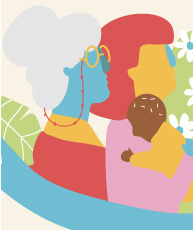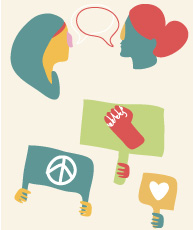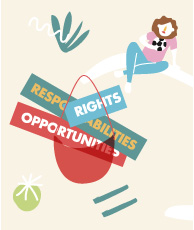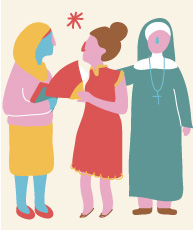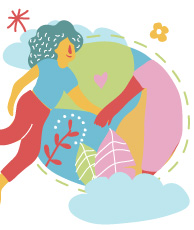World YWCA


Many leaders and activists in the broader women’s movement agree that words that once imparted visions of social change have become devoid of their original meaning. For example, words like safe spaces, empowerment, and engagement are being used differently by different members of the broader women’s movement. To remedy this, and provide leaders and on the ground activists with a common language, a glossary of definitions can be highly useful.
This glossary tries to account for the most commonly used words – whether they are “technical terms”, “operational words” or “specialized jargons”. It tries to provide definitions that can be easily understood by everyone, whether they are members of the movement, aspiring members, allies, partners or stakeholders who work with us.

It's time the tale were told of how you took a child and you made him old.

It's time the tale were told of how you took a child and you made him old.

It's time the tale were told of how you took a child and you made him old.

It's time the tale were told of how you took a child and you made him old.

It's time the tale were told of how you took a child and you made him old.

It's time the tale were told of how you took a child and you made him old.
Around the world, YWCA structures have always operated with a lot of independence. This independence is key towards relevance and success of our operations, at local, national and regional level. However, to ensure that what we do still fits into one global vision, it is important for us to come together and agree on a common language for the YWCA movement.
Many leaders and activists in the broader women’s movement agree that words that once imparted visions of social change have become devoid of their original meaning. For example, words like safe spaces, empowerment, and engagement are being used differently by different members of the YWCA movement and broader women’s movement.
To remedy this, and provide YWCA leaders and on the ground activists with a common language, a glossary of definitions was developed.
This glossary tries to account for the most commonly used words – whether they are “technical terms”, “operational words” or “specialized jargons”. It tries to provide definitions that can be easily understood by everyone, whether they are members of the movement, aspiring members, allies, partners or stakeholders who work with us.
It's time the tale were told of how you took a child and you made him old.
In 2015, the bold and transformative “Goal 2035” document was developed and approved at the Bangkok World Council. This goal states: “By 2035, 100 million young women and girls will transform power structures to create justice, gender equality, and a world without violence and war; leading a sustainable YWCA movement, inclusive of all women2”. In order to achieve this goal, the YWCA agreed to contribute space and resources; and to connect, mobilise and consult with on-the-ground leaders within and external to the YWCA .
Since then, an analysis of the movement’s past and present was conducted. This resulted in the development of The World YWCA 2020-23 Strategic Priorities and Key Initiatives4. These documents highlight the importance of developing and popularising tools for movement building. They include, as one of the World YWCA’s core tasks for 2020, the promotion word to move above development and promotion of a glossary of terms that is fit for use within the movement and with external stakeholders. The glossary will help in not just developing a com- mon understanding of the terms we use but also help work together towards Goal 2035.
It is extremely difficult to capture the full range and diversity of women’s voices and insights across decades of movement work. As such, this document is not – and will never be – complete or representative. Rather, it is an attempt towards understanding and popularising how women in the movement have used diffe- rent terms over different decades. In this spirit, we invite young women and women leaders to contribute to the continued edition of this document. Your additions and corrections, agreements or disagreements, ideas and inputs are what will turn this glossary into a key resource for the YWCA movement and broader women’s movement.
The contents of this glossary is reflective of the diversity of work being done by different YWCA entities and leaders. The words listed have been carefully chosen, and the definitions reflect the values and principles that have driven the YWCA system for decades.

It's time the tale were told of how you took a child and you made him old.

It's time the tale were told of how you took a child and you made him old.

It's time the tale were told of how you took a child and you made him old.

It's time the tale were told of how you took a child and you made him old.
Around the world, YWCA structures have always operated with a lot of independence. This independence is key towards relevance and success of our operations, at local, national and regional level. However, to ensure that what we do still fits into one global vision, it is important for us to come together and agree on a common language for the YWCA movement.
Many leaders and activists in the broader women’s movement agree that words that once imparted visions of social change have become devoid of their original meaning. For example, words like safe spaces, empowerment, and engagement are being used differently by different members of the YWCA movement and broader women’s movement.
To remedy this, and provide YWCA leaders and on the ground activists with a common language, a glossary of definitions was developed.
This glossary tries to account for the most commonly used words – whether they are “technical terms”, “operational words” or “specialized jargons”. It tries to provide definitions that can be easily understood by everyone, whether they are members of the movement, aspiring members, allies, partners or stakeholders who work with us.
In 2015, the bold and transformative “Goal 2035” document was developed and approved at the Bangkok World Council. This goal states: “By 2035, 100 million young women and girls will transform power structures to create justice, gender equality, and a world without violence and war; leading a sustainable YWCA movement, inclusive of all women 2 ”. In order to achieve this goal, the YWCA agreed to contribute space and resources; and to connect, mobilise and consult with on-the-ground leaders within and external to the YWCA 3 .
Since then, an analysis of the movement’s past and present was conducted. This resulted in the development of The World YWCA 2020-23 Strategic Priorities and Key Initiatives 4. These documents highlight the importance of developing and popularising tools for movement building. They include, as one of the World YWCA’s core tasks for 2020, the promotion word to move above development and promotion of a glossary of terms that is fit for use within the movement and with external stakeholders. The glossary will help in not just developing a common understanding of the terms we use but also help work together towards Goal 2035.
It is extremely difficult to capture the full range and diversity of women’s voices and insights across decades of movement work. As such, this document is not – and will never be – complete or representative. Rather, it is an attempt towards understanding and popularising how women in the movement have used different terms over different decades. In this spirit, we invite young women and women leaders to contribute to the continued edition of this document. Your additions and corrections, agreements or disagreements, ideas and inputs are what will turn this glossary into a key resource for the YWCA movement and broader women’s movement.
The contents of this glossary is reflective of the diversity of work being done by different YWCA entities and leaders. The words listed have been carefully chosen, and the definitions reflect the values and principles that have driven the YWCA system for decades.
This first edition was developed by Pauline Westerbarkey and Dr. Suchi Gaur from the World YWCA office. The document was reviewed and commented by a number of YWCA leaders, namely: Sydney Piggott (YWCA Canada), Donte Hilliard (YWCA USA), Talisa Avanthay (World YWCA), Nirmala Gurung (YWCA Nepal and World YWCA Regional Coordinator for Asia), Naomi Woyengu (YWCA PNG and World YWCA Regional Coordinator for Asia Pacific), Isabella Diaz (YWCA Honduras), Janet Mwaba (YWCA Zambia), and Rickol Julien (YWCA Grenada). Final edits have been done by Tina Bouffet and the illustrations were done by Eve Gentilhomme.
Many of the terms the World YWCA works with are not new to feminist movements and we have done our best to share the best works already published, as well as adding the World YWCA specific perspective. For more context on some of the terms, kindly consult the documents referred to below:
This first edition was developed by Pauline Westerbarkey and Dr. Suchi Gaur from the World YWCA office. The document was reviewed and commented by a number of YWCA leaders, namely: Sydney Piggott (YWCA Canada), Donte Hilliard (YWCA USA), Talisa Avanthay (World YWCA), Nirmala Gurung (YWCA Nepal and World YWCA Regional Coordinator for Asia), Naomi Woyengu (YWCA PNG and World YWCA Regional Coordinator for Asia Pacific), Isabella Diaz (YWCA Honduras), Janet Mwaba (YWCA Zambia), and Rickol Julien (YWCA Grenada). Final edits have been done by Tina Bouffet and the illustrations were done by Eve Gentilhomme.
